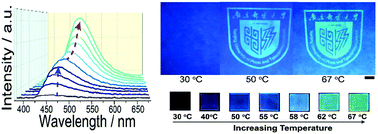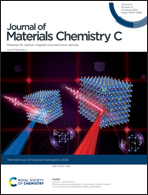Achieving multiple emission states and controllable response behaviour in thermochromic luminescent materials for security applications†
Abstract
Thermochromic luminescent materials (TLMs) demonstrate great potential for various photonic applications, especially in security information protection. In particular, the development of TLMs with more than two emission states and controllable response behavior is of great significance. However, it is still difficult and challenging to achieve the desired properties due to the lack of a proper design strategy. Here, we propose a simple and effective method to prepare TLMs, which involves the blending of polyethylene glycol (PEG) with a metal–ligand Fe(III) complex. The constructed TLMs exhibit three emission states of non-fluorescence, and blue and cyan emission colors, respectively, at different temperatures. Additionally, TLMs with various thermochromic transition temperatures can be easily obtained by using PEG matrices with different molecular weights. Ultimately, we demonstrate that these TLMs show immense potential in real-life anti-counterfeiting and security information printing. This work opens opportunities for achieving novel smart responsive materials with multiple emission states and controllable response behavior for advanced photonic applications.

- This article is part of the themed collections: Journal of Materials Chemistry C Emerging Investigators and Journal of Materials Chemistry C Lunar New Year collection 2021


 Please wait while we load your content...
Please wait while we load your content...